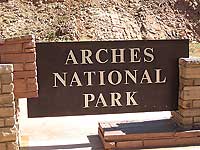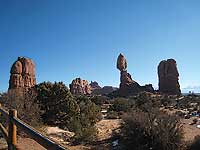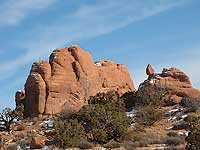 Feeling comfy-cozy inside my car makes me wonder – Do I really want to step outside and brave the elements? Just sticking my nose out the door to test the weather convinces me I need to bundle up with hat, gloves, lots of layers and a windbreaker. At 5,000 feet the temperature is 25 degrees and the nagging breeze has teeth in it. A few steps across the parking lot, and wham that frosty air hits me hard enough to almost convince me to try this short walk another day. I, however, came here to enjoy the off-season, mid-winter solitude (or so I thought), in Arches National Park and I’m determined to take advantage of it. But then I shouldn’t be surprised. After all, it’s only a few days past Christmas. Feeling comfy-cozy inside my car makes me wonder – Do I really want to step outside and brave the elements? Just sticking my nose out the door to test the weather convinces me I need to bundle up with hat, gloves, lots of layers and a windbreaker. At 5,000 feet the temperature is 25 degrees and the nagging breeze has teeth in it. A few steps across the parking lot, and wham that frosty air hits me hard enough to almost convince me to try this short walk another day. I, however, came here to enjoy the off-season, mid-winter solitude (or so I thought), in Arches National Park and I’m determined to take advantage of it. But then I shouldn’t be surprised. After all, it’s only a few days past Christmas.
Endowed with a stupendous concentration of sandstone arches this enchanting park also contains an equally astounding collection of other red rock formations. Within its 119 square miles, the geologic forces of gravity and erosion, which formed these outdoor windows, also created a wild, make-believe storybook land filled with colossal fins, soaring pinnacles, massive domes, and thick-walled stone castles. 
Balanced rocks, with their precarious weight distribution, have their own unique geological tale to tell. Our arid climate, alternating softer and harder rock layers, and the lack of earth tremors have provided ideal conditions for the formation of these bizarre looking creations. But even with the right ingredients, balanced rocks are still nature’s long shots. With astronomical odds against them, only by sheer chance have these extreme gambles paid off - a few winners that survive to perform the seemingly impossible feat of not toppling to the ground.
The granddaddy of them all is the well-known Balanced Rock, a prominent landmark in Arches National Park that can be seen for a long distance. From that perspective it gives the illusion of being much smaller than it really is. Only a close inspection reveals its staggering dimensions – the extension of the upper section is 55 feet and weighs in at a whopping 3,500 tons. The total structure measures in at 128 feet in height!
 How does Balanced Rock defy the force of gravity? The answer is the harder caprock layer of the Slickrock Member within the Entrada Sandstone that sits upon the softer mudstone layer of the Dewey Bridge Member. As the lower level weathered more quickly, the end result became a smaller pedestal tenaciously supporting the larger mass of rock above. The rate of erosion must be perfect for this geological trick to work - wearing so evenly that, rather than tipping over, the boulder instead remains perfectly balanced. But only for a bare instant in geologic time – gravity and erosion never give up - sooner or later every balanced rock tumbles to the ground. A perfect example was the nearby Chip Off The Old Block that plummeted to the ground during the winter of 1975-76. How does Balanced Rock defy the force of gravity? The answer is the harder caprock layer of the Slickrock Member within the Entrada Sandstone that sits upon the softer mudstone layer of the Dewey Bridge Member. As the lower level weathered more quickly, the end result became a smaller pedestal tenaciously supporting the larger mass of rock above. The rate of erosion must be perfect for this geological trick to work - wearing so evenly that, rather than tipping over, the boulder instead remains perfectly balanced. But only for a bare instant in geologic time – gravity and erosion never give up - sooner or later every balanced rock tumbles to the ground. A perfect example was the nearby Chip Off The Old Block that plummeted to the ground during the winter of 1975-76.
The pathway that circles Balanced Rock couldn’t be much shorter (less than one-third of a mile), nor could it possibly be much easier. In prime condition this is the interstate of trails. Starting out on concrete, it travels up a section of slickrock to some man-made sandstone steps that swing around to the snowy, shady side. Instantly the temperature drops and the deep freeze sets in. Hastily I am removing myself from Balanced Rock’s frigid shadow by stepping down another series of rock-based steps.
 During my walk around this imposing structure, I notice a drastic change in its appearance. On the familiar photogenic front side it looks cohesively dignified. But when I wander over to the backside, its features portray a different personality - a chunky rock structure that now suggests an oversized head on an extremely thin neck, way out of proportion to the rest of its enormous body. Looking over the layers in the scrawny neck, I am incredulous at the tremendous strength and stability that keeps this lopsided boulder glued in place! During my walk around this imposing structure, I notice a drastic change in its appearance. On the familiar photogenic front side it looks cohesively dignified. But when I wander over to the backside, its features portray a different personality - a chunky rock structure that now suggests an oversized head on an extremely thin neck, way out of proportion to the rest of its enormous body. Looking over the layers in the scrawny neck, I am incredulous at the tremendous strength and stability that keeps this lopsided boulder glued in place!
With a front row seat to observe the star of the show, the entertainment doesn’t stop with the main event. In all directions an outdoor theater stretches out over mesas and ridges: a tantalizing setting with another mini-sized balanced rock - endless topsy turvy sandstone formations - an arch within a huge wall - and an assortment of rock spires that thrust up from the ground like gigantic thumbs. The visual stimulation continues with the sheer ragged outline of Behind The Rocks and the alpine vision of the snow-laden Abajo and La Sal Mountains. Adding to this imagery is the layered, cliff-faced land that stretches all the way to the Colorado River corridor and beyond to the extensive dreamy-white profile of The Bookcliffs on the northern horizon.
 As I wander through the trademark high desert vegetation of junipers, pinyons, oaks, cliffrose, Mormon tea and blackbrush, the deep booming calls of ravens capture my attention. Glancing upward - there they are with their entertaining high-in-the sky flight. During the winter exodus when most birds have departed for the more abundant food in town or a warmer environment farther south, I can always count on the dramatic appearance of ravens. No matter how bitter the weather, these hardy, resourceful corvids always stick around. As I wander through the trademark high desert vegetation of junipers, pinyons, oaks, cliffrose, Mormon tea and blackbrush, the deep booming calls of ravens capture my attention. Glancing upward - there they are with their entertaining high-in-the sky flight. During the winter exodus when most birds have departed for the more abundant food in town or a warmer environment farther south, I can always count on the dramatic appearance of ravens. No matter how bitter the weather, these hardy, resourceful corvids always stick around.
Mid-way through this walk, I’m noticing more people than I had counted on. Then upon finishing my little exploration, I realize that the unexpected has happened. All parking spots are full and cars keep pouring in! Even in mid-winter, the lesson is - the early bird doesn’t have to jockey for a place to park. From around the world 1.5 million visitors a year travel to Arches, and our off-season, especially during a holiday, is becoming more popular. The reason is obvious: this park is a fabulous destination to visit any time of the year.
The entrance to Arches National Park is five miles north of Moab on Highway 191, and the parking area for Balanced Rock is nine miles farther up the main road.
|